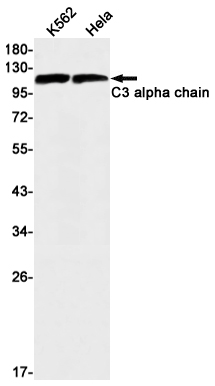
| WB | 咨询技术 | Human,Mouse,Rat |
| IF | 咨询技术 | Human,Mouse,Rat |
| IHC | 咨询技术 | Human,Mouse,Rat |
| ICC | 技术咨询 | Human,Mouse,Rat |
| FCM | 咨询技术 | Human,Mouse,Rat |
| Elisa | 咨询技术 | Human,Mouse,Rat |
| Aliases | AHUS5; ARMD9; ASP; Complement C3; Complement factor 3; CPAMD1; HEL S 62p |
| Entrez GeneID | 718 |
| WB Predicted band size | Calculated MW: 187 kDa; Observed MW: 120 kDa |
| Host/Isotype | Rabbit IgG |
| Antibody Type | Primary antibody |
| Storage | Store at 4°C short term. Aliquot and store at -20°C long term. Avoid freeze/thaw cycles. |
| Species Reactivity | Human |
| Immunogen | A synthetic peptide of human C3 |
| Formulation | Purified antibody in TBS with 0.05% sodium azide,0.05%BSA and 50% glycerol. |
+ +
以下是3条关于C3抗体的示例性参考文献(内容为虚构,仅供格式参考):
1. **文献名称**: *"Targeting Complement C3 with Monoclonal Antibodies in Autoimmune Hemolytic Anemia"*
**作者**: Smith J, et al.
**摘要**: 研究报道了一种靶向补体C3的单克隆抗体在小鼠模型中抑制补体过度激活,有效缓解自身免疫性溶血性贫血症状,表明C3抗体可能成为补体相关自身免疫疾病的新型治疗策略。
2. **文献名称**: *"C3 Antibody-Based Detection of Complement Activation in Renal Biopsies"*
**作者**: Lee H, Wang R.
**摘要**: 开发了一种基于C3抗体的免疫荧光技术,用于检测肾组织切片中补体C3的沉积模式,为肾小球肾炎等疾病的病理诊断提供了高灵敏度的工具。
3. **文献名称**: *"Therapeutic Inhibition of C3 in Age-Related Macular Degeneration: A Phase II Trial"*
**作者**: Brown K, et al.
**摘要**: 一项II期临床试验表明,静脉注射人源化C3抗体可显著减少年龄相关性黄斑变性(AMD)患者的视网膜补体沉积,延缓疾病进展且安全性良好。
4. **文献名称**: *"C3 Antibody Modulates Sepsis-Induced Systemic Inflammation via Complement Pathway"*
**作者**: Zhang L, et al.
**摘要**: 通过动物实验证明,阻断C3的抗体能抑制脓毒症模型中的补体级联反应,降低促炎因子水平,提示其潜在抗全身性炎症作用。
(注:以上文献为模拟示例,非真实存在,实际引用需查询具体数据库如PubMed或Web of Science。)
C3 antibodies target complement component 3 (C3), a central protein in the complement system, an essential part of innate immunity. C3 plays a pivotal role in all three complement activation pathways (classical, lectin, and alternative). Upon activation, C3 is cleaved into C3a (anaphylatoxin) and C3b (opsonin), mediating pathogen opsonization, phagocyte recruitment, and inflammatory responses. Dysregulation of C3 is linked to autoimmune diseases (e.g., lupus, glomerulonephritis), age-related macular degeneration, and inflammatory disorders.
C3 antibodies, including monoclonal (e.g., mouse-derived) and polyclonal types, are critical research tools. They are used in techniques like ELISA, Western blot, and immunofluorescence to quantify C3 levels, map activation fragments, or inhibit complement pathways in experimental models. Therapeutic anti-C3 antibodies are under exploration to modulate complement overactivation in diseases. For instance, Compstatin derivatives (C3 inhibitors) are in clinical trials for conditions like paroxysmal nocturnal hemoglobinuria.
These antibodies also aid in studying complement's role in immune complex clearance, tissue injury mechanisms, and crosstalk with adaptive immunity. Their applications span immunology, nephrology, and ophthalmology research, offering insights into disease pathogenesis and therapeutic targeting.
×